Translation revised by Michael S. Howard, June 2012
In The Chinese Origin of Playing Cards (1) William Henry Wilkinson suggested that Chinese cards, which probably appeared soon after the invention of printing around the 10th century, were actually paper currency, used both as gaming tools and as the stakes being played for. In the 1930s Stewart Culin, director of the Brooklyn Museum, published a study highlighting the presence of cards in China before 1100 A.D.: he stated that European cards came graphically from the paper money used during the Tang dynasty (608-908 A.D.), which bored the likenesses of emperors and high-level officials. The cards had three suits: Jian o Qian (Coins), Tiao (Strings of coins - the coins were holed and piled up on a string), and Wan (a Myriad, that is ten thousand). In addition to these cards there were three other single ones: Qian Wan (Thousands of Myriads), and Hong Hua (Red Flower) e Bai Hua (White Flower). Each suit had numbered cards, from 3 to 9.
The first known reference to Indian cards, called Ganjifa – word coming from the Persian ganjifeh (گنجفه), meaning “playing card” - goes back to a biography of Babur (early 16th century), the founder of the Mughal dynasty. They were circular and had suits composed of twelve subjects on coloured backgrounds, with pip cards running from 1 to 10 and two court cards, a minister or advisor and a king. It is uncertain whether these cards influenced the Mamluk Egyptian cards or vice versa. The fact is, however, that the so-called Mulûk wa-Nuwwâb deck, now at the Topkapi Sarayi Museum in Istanbul, dating from the 15th century but the same as a 12th-13th century card fragment , is composed of 52 cards divided into four suits: Jawkân (Polo Sticks), Darâhim (Coins), Suyûf (Swords) and Tûmân (Cups). Each suits has ten cards, numbered from 1 to 10 and three figures (or court cards) called malik (King), nā'ib malik (Viceroy or Deputy King) e thānī nā'ib (Second or Under-Deputy).
In the 14th century playing cards, called naibbe (a term of uncertain origin) by the Spanish, spread widely across Europe. We can assume that they appeared in the first half of the century, since the first related documents date from the second half. As matters now stand, the most accredited hypothesis is that our cards and their suits come from Mamluk Egypt whence they reached the West through commerce.
We are now going to analyse a possible Latin origin of card suits, based on the following information given by Fulvio Fava, who studies the matter: «About 200-300 B.C. Roman coins were called aes, specifically “aes signatum”, of a rectangular shape; these coins clearly show the designs of the ace of clubs, the ace of swords and the ace of coins, as well as a vase which might have led to the ace of cups. Since it is clear that the word Ace comes straight from the Latin term referring to coins (in fact in some regions a card game is called "scopa d'asse"), we should wonder whether in fact the suits of our cards come from the Latin world and not from the Arabic one. It is true that the historical comparisons based on antique decks and the absence of documents about their actual earlier diffusion in Italy would lead us somewhere else, but it is equally true that the first actual "explosion" of production and variety of styles occurred in Italy. If we observe the most antique cards from Piacenza and Naples (but also the present ones) we note that they are more similar to the coins than to Saracen cards (this is true both for the Aces, completely similar to the aes signatum, and for the suits corresponding to the designs of the later aes grave); I therefore think this is a kind of tribute to Italian history. I don’t know when it happened, but “our” suits are the same as the prototypes for Roman coins and consequently the first Italian coins, and this cannot and must not be considered as a casual coincidence» (2).
With regard to our analysis, the Vocabolario Etimologico della Lingua Italiana (Etymological Dictionary of Italian Language) by Ottorino Pianigiani (1907) writes about the term “asso” or “asse”: “Copper coin weighing twelve ounces, that is, a pound, called by the Romans AS (by the Greeks ÈIS, Doric dialect ES, Tarentine dialect AS) which means one. It comes from the Indo-European root AK, to see, which is also in the Sanskrit AKSA, ÀKSI, eye, wherefore the primitive meaning of eye (that is the dot or pip) of the dice and then the number one. It represented the monetary unit of the Romans: therefore the term itself gave the idea of the whole and was used to indicate Universality or Totality of goods. This is why the law still says Asse ereditario (hereditary) to denote the whole inheritance…(others liken AS to AES copper and metaph. coin, which they compare with the Sanskrit AYAS metal)”.
In Pianigiani’s opinion the term “ace” would therefore come from “asse”, directly originating from the analogy eye-small dot/pip and from the one of dice, to be later adapted also to the number one of playing cards. However a big obstacle to this reading is that it is now certain that aes does not come from AS but actually from AES, a term indicating the various copper mixtures (from the Sanskrit krsnam ayas = black metal , indicating not raw metals but fusion products, mainly bronze). This weakens the strained relationship between the die and the Roman coin and obliges us to look for other solutions: the first and most evident one is in fact given by Fulvio Fava’s considerations " the aces have their names because they are directly inspired by the pre-coins called "asse".
Let us now examine the coin called AES, used by the Romans from Numa Pompilio’s reign as reported by Pliny (3). In fact Numa introduced copper processing into the furnaces working gold and silver for monetary purposes. At first the coins were square, called later (4) because of the analogy to bricks and specifically Aes rude since they did not have any impression or embossment. As time went by, gold and silver coins took different shapes, while copper coins maintained their original square one. Pliny writes that it was Servius Tullius who added embossed symbols to the type of Aes which was called Aes signatum for this reason: “Servius rex primus signavit aes rudi ante usos romanus Timaeus tradit”. The name Aes grave was given to copper coins in the early fourth century, when they tendend to be circular and double-embossed, with the mark of the numbers of their legal value. The pictures below this article provide examples of Aes Grave marked with these values (embossed dots), among which are various figures with vases/cups and clubs.
Returning to the Aes signatum, the first types of embossments were armed trunks, that is, twigs with sharp-pointed leaves; later dolphins and tridents together with clubs and branches appeared. In the late epoch we find signs and symbols from the animal world (for example, oxen, chickens, pigs, elephants) together with the Roman eagle and popular or military tools, such as vases and swords. All the symbologies adopted refer to Roman history: for example the ox reminds us of the perimeter of the town traced by Romulus, the elephants are connected to the war against Pyrrhus as are the pigs which, as Aelianus reports in De Natura Animalium (1,38), were used to frighten the elephants: the pigs were covered with pitch and burned so that their groans frightened the elephants. In Le monete dell’Italia Antica (Coins of ancient Italy) byRaffaele Garrucci we find a lot of information justifying the presence of the various animals and the objects on the different types of coins of Aes signatum and Aes Grave. He writes about chickens: “The auspicious chickens avidly pecking at polenta and making with the pieces fallen on the ground the tripudium solistimum was considered to be a favourable sign” (5).
Men’s belief in the 14th century that playing cards had come from the Arabic world is confirmed in various documents of the time. As an example we remember the Cronaca di Viterbo, written by Giovanni di Juzzo di Covelluzzo, which reports the following information: “ Year 1379 the card game coming from Saracinia and called Naib was brought to Viterbo”; moreover in the inventory of the goods of the Duke and Duchess of Orléans (Louis of Valoise e Valentina Visconti) “ a deck of Saracen cards and a deck from Lombardy” are listed (1408). Obviously this is a very probable origin. The analytic philosopher Carlo Penco writes about it: “ Only the dates of the actual presence of European cards (1370) and the following reference to Islamic cards (1379) stand in favour of the proposition that Islamic cards come from European ones. If we wish to follow this way we must make improbable hypotheses: 1 – European cards first spread throughout Persia, later they reached the Arab countries in a very short time and came back to Europe after few years. 2 – European cards were used in Europe much earlier than 1370 and spread throughout the Arab countries via Persia. Not only are both the hypotheses highly improbable, but they have no historical justification at all” (6).
So it might be possible to hypothize that the Aes, which spread widely in the Imperial Age (7) at the time of the Persian wars, became so popular in the Middle-Eastern world as to suggest, many centuries later, the symbols to be inserted into the playing cards, where the dot value was replaced by the complete figures of the element of each suit. Since the word Ace comes from our Latin, all these considerations make the hypothesis proposed by Fulvio Fava very probable. If this were true, the coin suit would not depict coins but the figure of the Sun which in the Aes is constantly found combined with that of the Moon.
Certainly, beyond the similarity between some symbols in the Aes and in playing cards, it is surprising to observe how in a lot of antique cards we find the same figures of animals as in the Aes, such as the elephant which, at first in the Guadagni collection of Florence (which makes us presume it was found in Tuscan ground), later went to enrich the vast collection of the British Museum. And in fact the elephant is depicted in many decks of the Minchiate Fiorentine, as is shown in one of the cards below. Perhaps it is not due to a case that the image portrayed on the Three of Swords in the Minchiate is a wolf in the act of breast-feed Romulus and Remus.

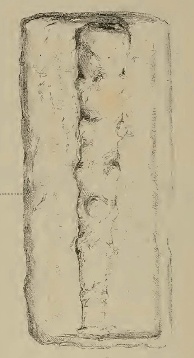
Aes signatum: Sword Aes signatum: Baton/Club
Unknown origin, British Museum Unknown origin, British Museum

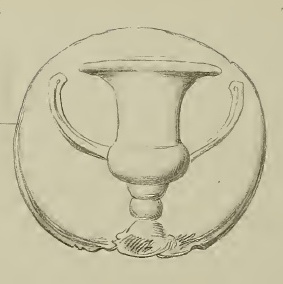
Aes grave: Globe of the shining Sun Aes grave: Vase / Cup
with 14 rays, 7 mayor and 7 minor Once at the Kircherian Museum in Rome
Umbrian origin. Once at the Kircherian Museum in Rome

Aes grave: Moon and Sun
The two sides of the above-described coin depicting the shining Sun
Umbrian origin. Once at the Kircherian Museum in Rome


Aes grave: Batons with note of value Aes grave: Baton with note od value
Apulian Origin Umbrian origin
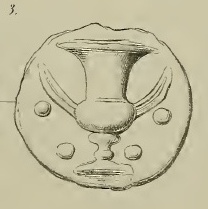
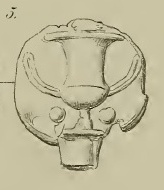
Aes grave: Vase / Cup with note of value Aes grave: Vase / Cup with note of value
Origin: Latium Origin: Latium
Once at the Kircherian Museum in Rome Once at the Kircherian Museum in Rome
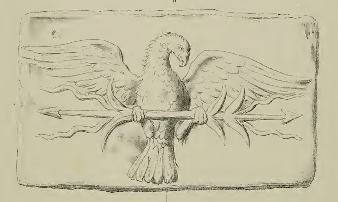
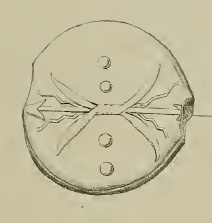
Aes signatum: Eagle with spear / lightning Aes grave: Spear/ Lightning
Found at Velletri with another Aes of the sword tipe with note of value
Once at the Kircherian Museum in Rome Once at the Kircherian Museum in Rome
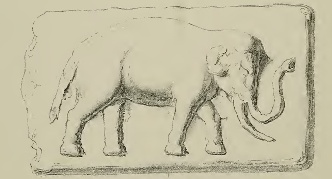

Aes signatum: Elephant Aes signatum: Pecking hens
Probable Tuscan origin, British Museum Unknown origin, British Museum
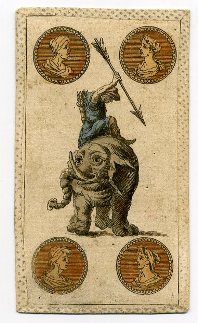
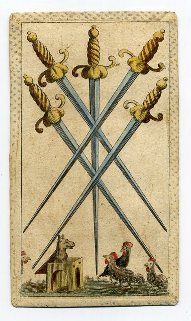
Four of Coins with elephant Five of Swords with hends
"Etruria" Minchiate from Florence, 18th century "Etruria" Minchiate from Florence, 18th century
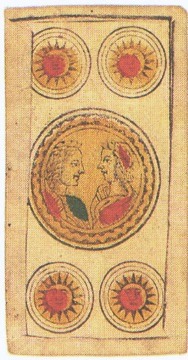
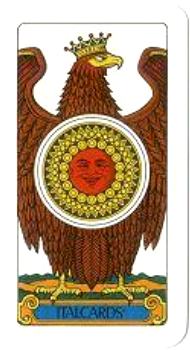
Five of Coins as shining Suns Ace of Coins as shining Sun with aegle
Playing card from Piacenza, XVIII century Present playing card from Piacenza
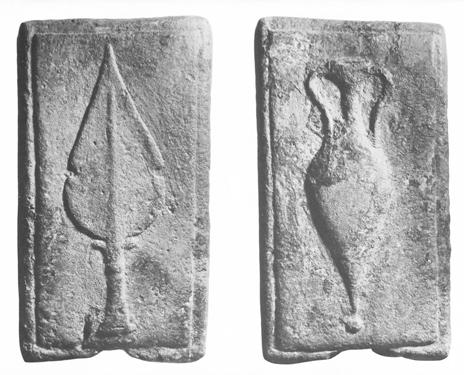
Aes sgnatum: Spearhead / Vase (front and back)
Rome, 280-240 b.c. London, British Museum

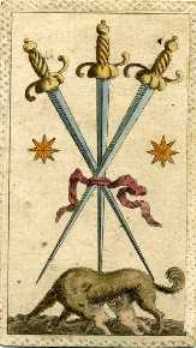
Ace of Cups Three of Swords
Playing card from a Sicilian deck "Etruria" Minchiate from Florence, 18th century
realized by Martino Azzarello, Palermo, 1924
Notes
1 - In The American Anthropologist, Volume VIII, January 1895, pages 61-78.
2 - Father Daniel was one of the first supporters of the derivation of Aces from Roman coinage. He brought out his thesis in the article Origine du jeu de pique, trouvé dans l'histoire de France (Origin of the game of Pique, found in the history of France), in "Journal de Trevoux", May 1720. Cited by Cesare Cantù, Storia Universale (Universal History), Volume X, Period XI, Turin, 1842, pp. 221-222. Father Daniel also claimed that the game of Tarot (Ludus Triumphorum) appeared prior to Piquet, which he placed at around 1430. A thesis which we find ourselves in perfect agreement.
3 - N. H. 1, XXXIII
4 - Varro, De Vita Populi Romani, pr. Nonio, 2, 481; 12,9. Pliny, H. N. XXXIII, 3,17.
5 - Rome, 1885, page 6.
6 - Carlo Penco, I Tarocchi di Dummett (Dummett’s Tarot), Draft 1.1.2011, pages 3-4.
7 - For the smaller values they had a copper aes (10.90 gr.), its multiples in orichalcum, a metal like brass, called dupondius (two aes) and sestertius (four aes); for submultiples we had a copper quadrant (1/4 of an aes)